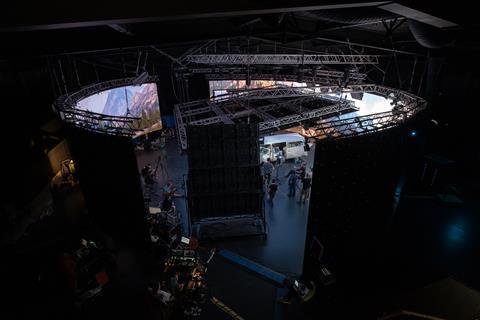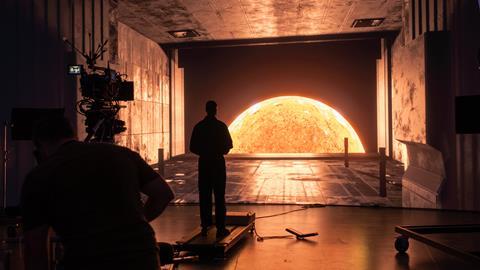The first in a six-part series providing insight into the burgeoning world of virtual production
Broadcast has teamed up with virtual production and volumetric capture specialist Dimension to present a six-part series of short films providing insight into shooting in LED Volume stages.
The series is focused on the ‘Virtual Production Innovation Project’, which was designed to explore the state-of-the-art in virtual production, testing different workflows and scenarios.

The project was conceived and produced by Dimension, DNEG, and Sky Studios, and filmed at Arri’s Uxbridge studio with support from partners Creative Technology and NEP Group. The aim is to share insights and expertise to the creative community, while helping upskill the next generation of creative talent.
“We get the environmental lighting, and it produces a much more convincing and realistic result than if we were just shooting against a standard backdrop” Paul Franklin, creative director, DNEG
The project was directed by Paul Franklin at DNEG. He said: “Speaking as a filmmaker, the Sky Virtual Production Innovation Project was a dream come true. Working with a state-of-the-art LED volume, I was able to explore a wide range of dramatic scenarios ranging from urban locations through natural landscapes to deep-space sci-fi worlds – all on the same stage. The photographic realism that can be achieved is astonishing – I can’t wait to shoot in the Volume again.”
The first episode in the six-part series (see the box below) explores the results of interactive lighting being used on an LED wall and how it influences realistic reflections in its environment. The LED wall environment lights the actor and inherently looks more real and gives reflections straight away.
VIRTUAL PRODUCTION INNOVATION SERIES – LIGHTING
Featured in the video:
Mark Gillespie | 1st AD
Dale McCready | Cinematographer
Paul Franklin | Director | DNEG
Paul Franklin, creative director of DNEG, said: “Unlike translights or front-projection, the LED Volume is bright enough to function effectively as a light source for the set. In some circumstances, the illumination from the LED screen is enough to provide most or even all the lighting needed for the set, for example in a twilight or dawn scene. But if hard directional light is needed – for instance, in a bright daylight environment – then additional practical lighting will be needed. It’s important to remember that the LED is, in effect, a giant television screen on the stage. As such, it produces a soft, diffuse light source – it will never create hard defined shadows. All that being said, the possibilities with the LED screen light source are incredible, as the image on the screen changes, so does the lighting on the set.”
Asked about his hints and tips for lighting in virtual production, Franklin suggests: “You should think about the effect that you want to create, the world you want to put on screen, and then figure out what needs to be in the image on the LED screen and what other lights you will need to add to create the desired look. The real key to getting this right is to make sure that you have enough prep time to make sure that everything is working the way that you want it to as there will almost certainly not be enough time to do this once you are actually shooting. The testing period will allow you to rule out things that aren’t going to work, but it will also show you things that you maybe didn’t expect and will subsequently want to take advantage of. Speaking as a director, your most important relationship will be with the director of photography, this is the person who will make this all work on the set, so it’s important that they get as much time as possible to familiarise themselves with the way the LED screen works and what it offers them for lighting the set.”
The series of six films explaining different learnings from the project will be released weekly throughout March and April, exclusively on Broadcastnow.
Each episode discusses the tests the team has undertaken and demonstrates some of the advantages of virtual production in capturing in-camera VFX and final pixel shots using an LED volume.

Alongside the film, we’ll present an exclusive interview with one of the key members of the production team, talking about the insights offered in that week’s episode and the lessons they learned during the making of the Virtual Production Innovation Project films.
The series will cover Lighting, Tracking, Simulcam, In-camera effects, Scanning, and 360 Photospheres. Broadcast’s interview with Dimension head of real-time and virtual production, Ed Thomas about lighting is below.
Broadcast interview with Dimension head of real-time and virtual production Ed Thomas

What effect does the LED Volume have on the realism of reflections?
Depending on the coverage or the actual surface of the LED walls the effect on reflective and semi-reflective surfaces is very convincing. Also, every single surface on-set is somewhat reflective and every surface will respond to the on-set lighting in a physically correct way in the same manner as they would if the set was physically built around them. This gives the surfaces a very realistic feel that is difficult to replicate with traditional lighting setups alone.
Is it easier to create authentic lighting for different scenes in virtual production, compared to traditional production?
It’s not that it’s easier, although in some ways it is, but it’s rather that it can be more flexible to change the lighting in a reactive and interactive manner. Traditional physical lighting scenarios rely on extensive pre-production to identify the look of the desired lighting and then the physical manifestation of those lights and the provisioning of them on set. With the lighting being generated from the LED wall it can be driven in realtime to best respond to the dynamic nature of on-set production. Elements such as colour, intensity and direction can all be adjusted on a shot by shot basis with very little physical dependencies on-set. This makes it very attractive as it allows for a high degree of flexibility and creativity when actually on-set and rolling on talent.
You can find out more about Dimension Studio and its work with virtual production, by clicking here.






























No comments yet